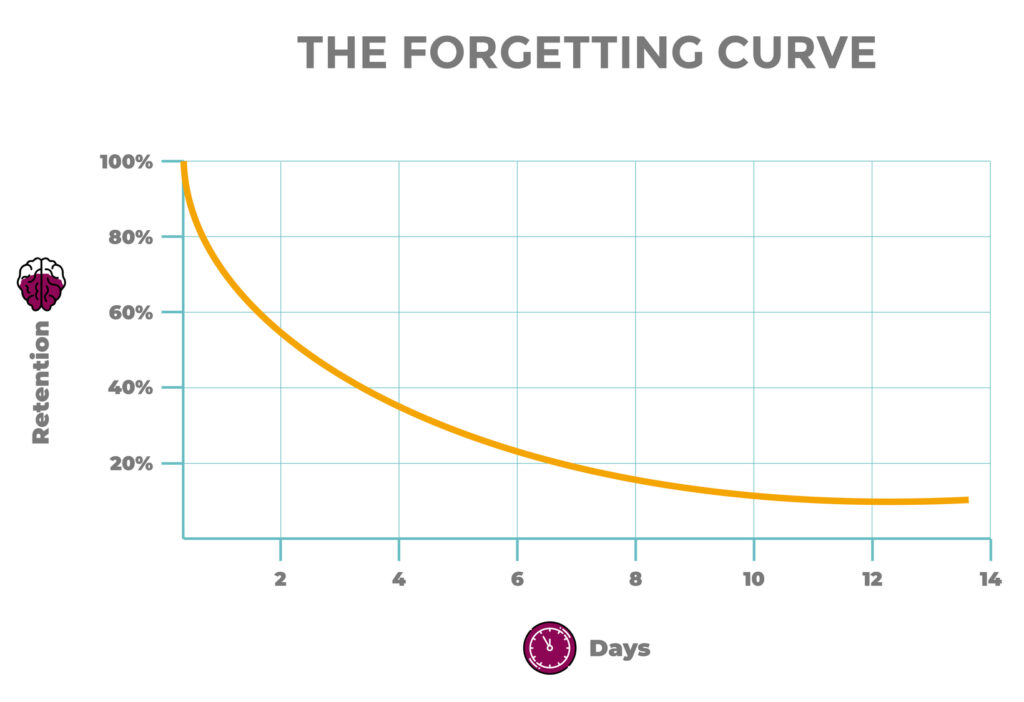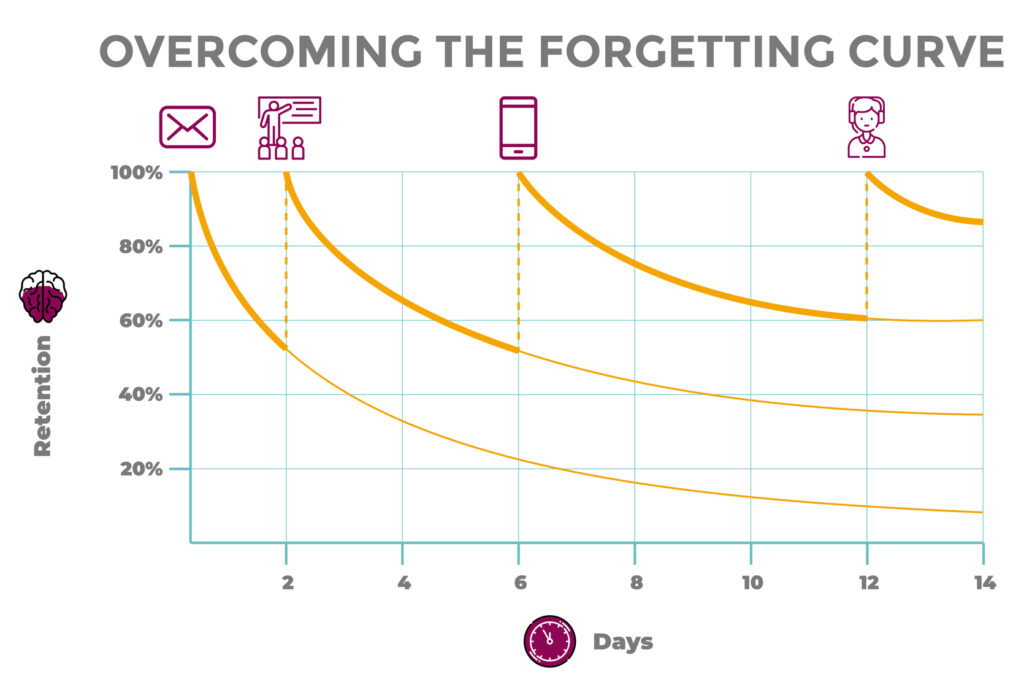One of our key drivers at Crucial Safety is to ensure you remember as much as you can once your training is over, meaning you can apply your new knowledge and skills in real life situations. After all, what’s the point of doing a training and forgetting most of it within a month (which is quite usual following intensive trainings)?
We’ve been listening to the world’s leading educational experts and cognitive scientists to make sure that what you learn in our courses sticks. Read more about the forgetting curve, and how to overcome it, in this blog.
What is the ‘forgetting curve’?
We’ve all heard of the ‘Learning Curve’, which is how quickly and effectively different people learn. We’ve known about it for well over a hundred years, since 1885, when a German psychologist called Hermann Ebbinghaus carried out a series of experiments about how people learn. What’s less well known is that, alongside the Learning Curve, Ebbinghaus also discovered the ‘Forgetting Curve’. This is how quickly people forget what they’ve learnt. The Forgetting Curve looks something like this:

The Forgetting Curve shows that we forget things rapidly – we forget a lot of what we learn within a day, and most of what we learn within a week of learning it. That’s because if new knowledge stays only in the brain’s short-term memory (which retains things only very briefly), or only creates a weak trace in long-term memory, it’s simply impossible to retrieve it at a later date.
So is training ineffective?
Well, that depends how it’s done. If new knowledge and skills are learnt and then almost instantly forgotten, then yes, arguably it is fairly ineffective. But there are ways to improve our remembering and strongly shift new learning into long term memory, thereby making training much more effective.
The first is to deliver engaging and interactive training that allows participants to really ‘get their hands dirty’. In other words they have to practice what they have learnt in realistic settings, using realistic, real-life exercises. This helps. When learning about how to do a security threat assessment participants should actually do a simulated threat assessment. But this still doesn’t overcome the issue that much detail is still forgotten pretty quickly, leaving a ‘vague impression’ of learning a couple of months later.
I’m prepared to bet that on the final day of an intensive week-long Security Management training many participants will struggle to clearly recall and explain in detail what they learnt on day one. Even following a highly interactive crisis management simulated exercise, participants will find it difficult to describe in detail the following week what they learnt. Their brains have taken in so much information during the trainings that they suffer from ‘overload. This intensive ‘cramming’ approach is known by cognitive scientists to be an ineffective way to learn. The brain needs time, space and repetitive practice to take in new information, and this has been demonstrated over and over again by researchers.
What’s the answer?
The pandemic has given us a chance to step back from our crazy ‘hamster wheel’ day-to-day existence and think hard about what good training should look like. As part of this thinking we have done a lot of reading on the best learning approaches for adult education. And the research from the educational and cognitive psychologists is clear: there are two highly effective approaches to learning and retaining information that beat everything else by far.
The first is to return to new knowledge regularly over time, using what is known as ‘distributed’ or ‘spaced’ practice. This means learning something new on day 0, revisiting it briefly on day 2, considering it again from a different angle on day 6, being asked to recall what you have learnt on day 12, writing something short about it on day 20, listening to a brief podcast on day 40. In this way, new knowledge has time to create strong memory traces and ‘bed in’ to long term memory, meaning it will be available to use in the future when needed in real life situations. The information has shifted from short-term memory to long-term memory.
The second, referred to in the paragraph above, is the need for learners to try to actively recall information over time to allow them to see what they have remembered and what they have forgotten. This should be done in a structured way, and with clear feedback when answers are incorrect. This, too, creates strong long-term memory traces.
Combining these two key approaches helps massively to reduce the forgetting curve. It looks like the diagram below:

The diagram shows an example of what overcoming the forgetting curve could look like using the techniques. A learner receives an email containing new learning on day 0; this could be an article or a document to read, or something else. On day 2 there is a taught element where a trainer or instructor leads a discussion about the new learning. On day 6 there is a further engagement using a mobile phone – perhaps the learner receives a short video to watch, or has to take a brief quiz on the new knowledge. On day 12 the learner listens to a podcast on the topic, and so on. Through regularly re-engaging with the material it effectively absorbs into long-term memory. You can see by the end of day 14 the learner is remembering over 80% of what they have learnt compared to just 10% in the top diagram.
The future of training
Clearly, this very widely accepted research challenges us as trainers, and forces us to think hard about the future of how we deliver security training. If the experts tell us that distributed practice and active recall of information is the best way to learn, we should be including these as central pillars of our training approach. And this will require a rethink about how we deliver training. Five-day intensive face-to-face courses may still be relevant, but only if they are followed up vigorously over time with multi-media, videos, podcasts, reading, mentoring, and – where time and resources allow – live follow-up webinars. Ideally, courses will also be preceded by pre-course work that can be monitored and quality-controlled.
Alternatively, online training is an effective way to deliver the twin benefits of distributed practice and active recall over time. It’s the reason Crucial Safety was established – to concentrate on new and highly effective approaches to the delivery of training.
It’s quite possible to do all of this, and I’d argue that to improve training effectiveness we have to do it. We have to be led by the most up-to-date research evidence and rethink our approaches when the evidence shows us it’s necessary.
It may take a little more time and effort, but if the end result is training that is more effective it is surely worth it, and may be more cost-effective too.








